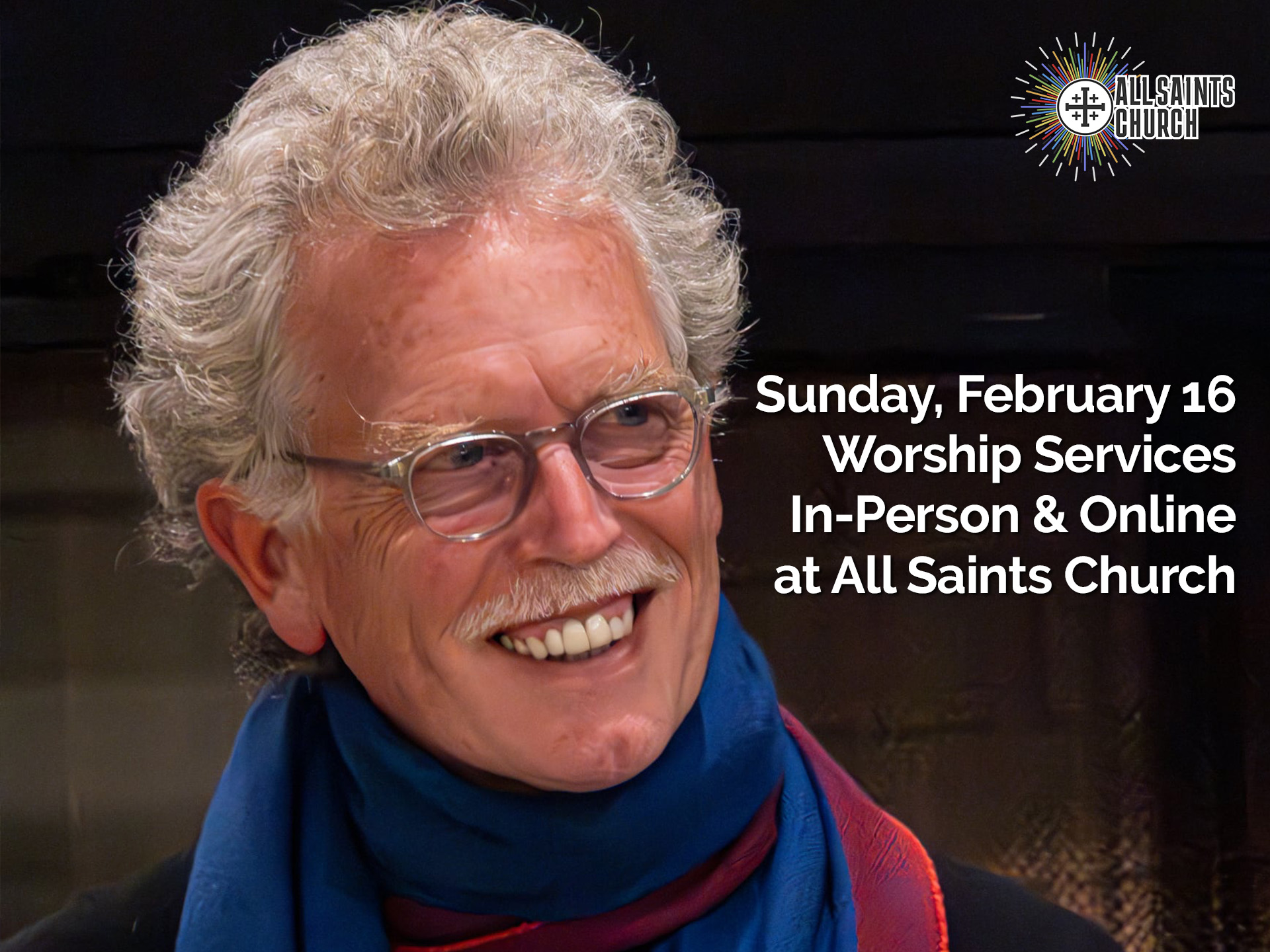Sermon preached at All Saints Church on Sunday, August 6, 2017 by Mike Kinman.
While Jesus was in prayer, the appearance of his face changed and his clothes became blinding white.
+
About 10 years ago a movie called Talladega Nights came out where Will Ferrell plays a NASCAR driver named Ricky Bobby. And there’s a famous scene about halfway through the movie where Ricky and his family are gathered around the dinner table, and Ricky is saying grace. Now Ricky likes to pray to Baby Jesus.
Dear Lord Baby Jesus, in your golden fleece diapers, with your tiny little fat, balled up fists.
Now this starts an argument. What Jesus should they pray to?
Ricky’s father in law, Chip, protests: “He was a grown man. He had a beard!”
And Ricky says, “I like the baby version the best, do you hear me? I win the races and I get the money.” And for him, that should settle it.
But then Ricky’s racing partner, Cal, gets going. Cal says: “I like to picture Jesus in a tuxedo T-shirt, ‘cause it says, “I wanna be formal, but I’m here to party, too.” Cause I like to party, so I like my Jesus to party.”
Then Ricky’s son Walker says: “I like to picture Jesus as a ninja fighting off evil samaurai.”
And Cal comes back. “I like to think of Jesus, like, with giant eagle’s wings. And singing lead vocals for Lynyrd Skynrd, with, like an angel band. And I’m in the front row, and I’m hammered drunk.”
And then, “I like to think of Jesus as an Ice Dancer, dressed in an all-white jumpsuit, and doing an interpretive dance of my life.”
It’s a great scene, and certainly has inspired a decade of table graces that begin, “Dear Lord Baby Jesus…” But it’s also a great scene because, certainly unintentionally, it reveals some big truths.
First, we have images of Jesus, and they are important to us.
Second, those images both shape who we believe Jesus is and either challenge or reinforce who we believe we are supposed to be.
I like to party, so I like my Jesus to party.
Finally, whoever has the power gets to determine which image of Jesus gets used.
I win the races and I get the money and I like the baby version the best.
So, this morning we hear this from Luke’s Gospel:
About eight days after Peter had acknowledged Jesus as the Christ of God, he climbed the mountain to pray, taking Peter, John, and James along. While he was in prayer, the appearance of his face changed and his clothes became blinding white.
The Transfiguration is one of the more powerful visual images of the Gospel. Jesus, like Moses before, goes on the mountain and communes with God and what happens? Jesus becomes white.
Now the Gospel writer was not making a racial statement … the text only speaks about Jesus’ clothes being white. But for us, the connection is still there. Jesus at his most glorious, at his most divine … is white. And what’s important to notice is that for most all of us, we don’t bat an eye – because a white Jesus seems perfectly normal.
I remember in first grade Sunday school being asked to draw a picture of Jesus. Like all the other kids, I drew a picture of a white man. Unlike all the other kids who drew him in flowing robes, I drew my Jesus in a suit and tie. Seems my Jesus didn’t like to party.
Now looking back, I can laugh — like my Sunday school teacher did – but the truth is that even at age six, I had internalized that Jesus was three things – white, male and respectable. Why? Because that was the Jesus I had been shown. Jesus was white, male and respectable. And as a young respectable, white male myself, that was fine by me.
Because Respectable White Male Jesus made me feel good about who I was.
Respectable White Male Jesus affirmed the rightness of a world where the power was held by respectable white men.
Respectable White Male Jesus taught me how to be a good respectable, White American Christian. And a good Respectable White American Christian knows that Respectable White Male Jesus is more concerned with order, respectability and preserving the peace and not so concerned with justice and everyone being treated with dignity.
A good Respectable White American Christian knows that Respectable White Male Jesus is more concerned with being nice and not so concerned with speaking the uncomfortable truth that will let the oppressed go free.
Respectable White Male Jesus speaks of reconciliation without speaking of equity, which only guarantees that those on the margins must be reconciled to staying there.
Respectable White Male Jesus tells us in a nation built largely by black and brown labor with resources stolen from black and brown lands that the rest of us should talk about welcoming those among us who are black and brown as hospitality extended to the stranger instead of recognizing that it is those of us who are respectable and white who are visitors in a house that we neither built nor maintain and that the conversation should not be about charity but reparation and revolution.
Yes, we have different images of Jesus. And those images shape who we believe Jesus is and who we believe we are supposed to be. And whoever has the power gets to determine the image of Jesus that gets used by the community.
And so, for most of Christian history, our voice at the table has said: White men have the money and white men have the power, and white men like Respectable White Male Jesus the best.
And that has settled it.
You know, there is no language you have to learn to follow Jesus. There are holy places, but there is no geographical center to following Jesus. Jesus is translatable into any culture, and the way we know that is we have so effectively translated Jesus into respectable white, male heteronormative culture not only in Europe and America but all over the world.
The story of the spread of Christianity is largely the story of respectable, white men taking a Jesus who was a dark-skinned revolutionary refugee preaching dismantling of empires for the liberation of the oppressed and turning that Jesus into a respectable white man and using him as an instrument of oppression for the very structures of Empire Jesus sought to dismantle and against the very people Jesus sought to free.
It didn’t have to be that way, but it was.
It doesn’t have to be that way, but it still is.
And so, as we hear the story of the transfiguration this morning, the challenge before us is how can we let Jesus be transfigured again and us with him. How can we let Respectable White Male Jesus be changed back into the true Jesus of the Gospels — and how can we let that Jesus lead us into dismantling the oppressive structures that have used Jesus against God’s children for nearly two thousand years?
In his brilliant book, The Politics of Jesús, Miguel de la Torre talks about the importance of taking Jesus back from the respectable white male power structures that have held him hostage for centuries. To preach the Gospel story not of Jesus, Peter, James and John but of Jesús, Pedro, Santiago y Juan.
Because that difference makes all the difference.
Just imagine, if every time you walked into a church, not just this morning, but every time your whole life, you had seen not the white religious iconography with peaceful pastoral scenes that makes up every single image of Jesus in this room, but instead had seen Black Mary holding her Black Baby Jesus being driven out of her home. Black Jesus confronting the white religious authorities and slaying them with his rhetoric. What if instead of a stained-glass window with the white faces of people who made generous financial gifts to All Saints Church generations ago, the visual focal point of our worship was Black Jesus being incarcerated and executed for protesting state violence? How would that change how we experience Jesus? How would that change how we follow Jesus in the world?
What if instead of hearing the Gospel story as it was told this morning, not just today but every time throughout our lives we heard this story instead:
Now about eight days after Pedro had acknowledged Jesús as El Cristo de Dios, the Christ of God, Jesús took Pedro, Juan and Santiago and went up onto a cerro to pray. While Jesús was praying, his face changed in appearance and the clothes he wore became like the color of his skin, full of deep, dark, rich, powerful, beautiful color. Suddenly two hombres were there talking with Jesús: Moisés and Elías. They appeared in glory and spoke of the prophecy that Jesús was about to fulfill in Jerusalén. Pedro and the others had already taken a siesta, but awakening, they saw Jesús’ glory, and the two who were standing next to him. When the two hombres were leaving, Pedro said to Jesús, “Rabino, que bien que nos quedemos aqui… Rabino, how good it is for us to be here! Let us set up tres carpas, three tents — una for you, una for Moises and una for Elias!” Pedro ni sabía lo que estaba diciendo – Pedro did not really know what he was saying. While Pedro was speaking (in Spanish of course), a cloud came and overshadowed them, and the disciples grew fearful as the others entered it. Then from the cloud came a voice which said, “Este es mi Hijo amado. This is my Own, my Chosen One. Listen to him- Escúchenlo.” When the voice finished speaking, they saw no one but Jesús standing there.
If we had been shaped by these images and these stories, if they had been the central images and stories and not just occasional accessories for the sake of diversity, how would our faith be different? How would we be different? How would this church be different? How would our world be different?
If we had been shaped by these images and these stories, three years after the state sanctioned murder of Michael Brown would we still be content with policing in America that is more closely characterized by our president’s call for brutalization of people of color than about truly protecting and serving the most vulnerable among us.
If we had been shaped by these images and these stories would we still be content with Romulo Avelica, a day laborer and pillar of our community, spending his sixth month in jail and facing deportation for no other reason than the color of his skin?
If we had been shaped by these images and these stories, would we still be talking about charity instead of reparation and inclusion instead of revolution?
If we had been shaped by these images and these stories, how much of what we accept as normal would be revealed as intolerable?
De la Torre writes:
“Why is Jesús, over and against Jesus important? Because the Euroamerican Jesus has historically been used … to divinely justify societal actions that have silently contributed to or loudly maintained the marginalization of U.S. Hispanics.
“The Euroamerican Jesus is the Jesus of President James Polk, who following the quasi-religious ideology of Manifest Destiny, led the United States in the military conquest of northern Mexico, preventing the future ability of that nation to build wealth, and disenfranchised those for whom the border “crossed over.”
“The Euroamerican Jesus is the Jesus of Theodore Roosevelt who instigated a “gunboat” diplomacy that denied Latin American nations their sovereignty and provided U.S. corporations the freedom of and protection f or extracting the cheap labor and natural resources of a people. These first imperialist steps resulted in the pauperization and migration to the United States of Spanish-speaking peoples from Central America and the Caribbean northward.
“The Euroamerican Jesus is the Jesus of present day presidents and politicians (conservative and liberal) whose main purpose is the maintenance of U.S. global hegemony. This Jesus is silent as tens of thousands of Brown bodies die along our southern border, attempting to follow the resources and cheap labor stolen from their home nations. Or the millions of undocumented Latina/os who live in the shadows of Empire because their labor is wanted but not their physical presence.”
When we hear God say of White Jesus, “This is my son, my chosen, listen to him.” – we are hearing God anoint whiteness. We are giving the dominant culture, the forces of Empire, the blessing and force of the divine. For those who are the marginalized, for those who are Black and Brown in a White world, being told to listen to White Jesus turns Jesus the Liberator into Jesus the Oppressor and tells them to obey … lest the very power of God rain down upon them. Or at best even if this Jesus will save them it is just one more way they are dependent on a white man for their salvation. Either way, who has the power is clear.
But that is not the Gospel. The church may anoint white Jesus but God does not.
God points to Jesús and says, “This is my chosen. My chosen is a day laborer. My chosen is one whose family fled his native country in fear. My chosen is one who came from a barrio on the wrong side of town from where others say nothing good could ever come. My chosen is beautiful and powerful. Listen to her.”
God points to Black Jesus, the Jesus whom Ghanaian poet Afua Kuna calls “Lion of the grasslands” and “Chief among chiefs.” God points to Black Jesus and says “This is my chosen. My chosen was stolen from her homeland and had labor tortured out of her body to build this nation. My chosen is beautiful & powerful. Listen to her.”
God points to Lesbian, Gay, Bisexual, Trans and Gender Nonconforming Jesus and says, “This is my chosen. My chosen is legislated against and beaten and left for dead just because of who they are and who they love. My chosen is beautiful and powerful. Listen to them.”
But there’s even more.
It is not only important for every marginalized group to be able to hear and see God point to one who looks like them and say “this is my chosen, listen to her,” it is active violence against the marginalized among us to compel worship of Respectable White Male Jesus because Respectable White Male Jesus has and continues not to free but to kill those oppressed by this culture of Empire. AND the transfiguration of White Jesus into a Jesus of color is just as important for those of us for whom Respectable White Male Jesus is an affirmation of everything we are and benefit from.
What is it for those of us who are white to listen to a chosen one of God who is not like us? It is nothing less than our salvation. It is the heart of the Gospel – following a God who is, as Howard Thurman wrote, the Jesus of the disinherited. A God from the margins, reminding us that our greatest joy and salvation comes when we stop centering ourselves and join Jesús on the margins. A God who instead of upholding the structures of Empire challenges us to join her in examining who sits at the tables of power and authority in our nation. In our city. In this congregation. Is it the chosen of God? Is it Jesus or Jesús? Is it just the CEO of the Boardroom or the Lion of the Grasslands? Is it just the one who gives charitably to the poor and the outcast or is it the one who is the poor and outcast herself?
Jesús, Black Jesus, Trans Jesus, Homeless Jesus, all of God’s anointed challenge us to look at who is sitting at our tables of power, and to join the revolutionary Jesús, the Chief among Chiefs who came not to protect those tables of power for the benefit of a few but to turn them over for the liberation of all.
And so as we hear the story of the transfiguration this morning, the challenge before us is how can we offer up the images we have of Jesus, the music we sing to Jesus, the ways we follow Jesus, every aspect of our common life and let Respectable White Male Jesus be changed back into the true Jesús of the Gospels.
How can we let that Jesús lead us into dismantling the oppressive structures that have used Jesus against God’s children for nearly two thousand years?
How can we let Jesus – and us — be transfigured again?



